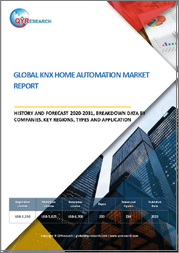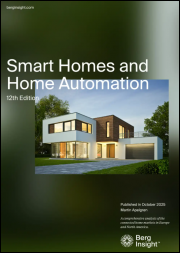
|
시장보고서
상품코드
1670748
세계의 홈 오토메이션 시장 규모, 점유율, 성장 분석 : 컴포넌트별, 네트워크 기술별, 최종사용자별, 지역별 - 산업 예측(2025-2032년)Home Automation Market Size, Share, and Growth Analysis, By Component (Product, Services), By Network Technology (Wired, Wireless), By End User, By Region - Industry Forecast 2025-2032 |
||||||
홈 오토메이션 세계 시장 규모는 2023년 882억 달러, 2024년 1,008억 1,000만 달러에서 2032년에는 2,936억 9,000만 달러로 성장하고, 예측 기간(2025-2032년) 동안 14.3%의 연평균 복합 성장률(CAGR)을 보일 것으로 예상됩니다.
홈 오토메이션 시장은 원격 제어 및 인터랙티브한 경험에 대한 소비자 수요 증가로 인해 강력한 성장세를 보이고 있습니다. 스마트 어시스턴트는 점점 더 널리 보급되고 있으며, 시장 확대를 더욱 촉진하고 있습니다. 센서, 액추에이터, 컨트롤러, 소프트웨어 등 필수 구성 요소들이 서로 협력하여 가정의 편의성, 에너지 효율, 보안을 향상시킵니다. 시장 가격은 시스템의 복잡성, 장치 수, 브랜드에 따라 크게 달라집니다. 신흥국 시장에서의 사물인터넷의 보급은 가처분 소득 증가와 소비자의 선호도 변화와 맞물려 시장 성장을 가속할 것으로 예상됩니다. 이러한 기존 생활에서 스마트 홈으로의 전환은 효율적인 에너지 사용과 기술 발전에 대한 인식 증가와 함께 홈 오토메이션 솔루션이 활발하게 성장할 수 있는 환경을 조성하고 있습니다.
목차
서론
- 조사 목적
- 조사 범위
- 정의
조사 방법
- 정보 조달
- 2차와 1차 데이터 방법
- 시장 규모 예측
- 시장 전제조건과 제한
주요 요약
- 세계 시장 전망
- 공급과 수요 동향 분석
- 부문별 기회 분석
시장 역학과 전망
- 시장 개요
- 시장 규모
- 시장 역학
- 성장 촉진요인과 기회
- 성장 억제요인과 과제
- Porter의 Five Forces 분석
주요 시장 인사이트
- 중요 성공 요인
- 경쟁 정도
- 주요 투자 기회
- 시장 생태계
- 시장의 매력 지수(2024년)
- PESTEL 분석
- 거시경제 지표
- 밸류체인 분석
- 가격 분석
- 규제 상황
- 사례 연구
- 기술 진보
홈 오토메이션 시장 규모 : 컴포넌트별&CAGR(2025-2032)
- 시장 개요
- 제품
- 보안 및 안전성
- 공조 설비
- 건강 모니터링
- 스마트 가전
- 스마트 엔터테인먼트
- 스마트 조명
- 기타
- 서비스
- 컨설팅
- 설치 또는 구현
- 지원 및 유지관리
홈 오토메이션 시장 규모 : 네트워크 기술별&CAGR(2025-2032)
- 시장 개요
- 유선
- 무선
- 전력선 기반
홈 오토메이션 시장 규모 : 최종사용자별&CAGR(2025-2032)
- 시장 개요
- 집합주택
- 단독주택
홈 오토메이션 시장 규모 : 지역별&CAGR(2025-2032)
- 북미
- 미국
- 캐나다
- 유럽
- 독일
- 스페인
- 프랑스
- 영국
- 이탈리아
- 기타 유럽
- 아시아태평양
- 중국
- 인도
- 일본
- 한국
- 기타 아시아태평양
- 라틴아메리카
- 브라질
- 기타 라틴아메리카
- 중동 및 아프리카
- GCC 국가
- 남아프리카공화국
- 기타 중동 및 아프리카
경쟁 정보
- 주요 5개사 비교
- 주요 기업의 시장 포지셔닝(2024년)
- 주요 시장 기업이 채택한 전략
- 최근 시장 동향
- 기업의 시장 점유율 분석(2024년)
- 주요 기업 개요
- 기업 상세
- 제품 포트폴리오 분석
- 기업 부문별 점유율 분석
- 전년대비 매출 비교(2022-2024년)
주요 기업 개요
- Leviton(USA)
- Aeotec(Germany)
- Siemens Building Technologies(Switzerland)
- Legrand(France)
- Hager Group(Germany)
- Schneider Electric(France)
- Honeywell(USA)
- Johnson Controls(USA)
- ABB(Switzerland)
- Bosch(Germany)
- Panasonic(Japan)
- Samsung Electronics(South Korea)
- LG Electronics(South Korea)
- Sony(Japan)
- Crestron Electronics(USA)
- Lutron Electronics(USA)
- ADT(USA)
- Alarm.com(USA)
- Resideo Technologies(USA)
- Somfy(France)
결론과 제안
LSH 25.04.11Global Home Automation Market size was valued at USD 88.2 billion in 2023 and is poised to grow from USD 100.81 billion in 2024 to USD 293.69 billion by 2032, growing at a CAGR of 14.3% during the forecast period (2025-2032).
The home automation market is experiencing robust growth driven by rising consumer demand for remote operations and interactive experiences. Smart assistants are increasingly popular, further propelling market expansion. Essential components like sensors, actuators, controllers, and software work together to enhance convenience, energy efficiency, and security in homes. Market prices vary significantly based on system complexity, device count, and brand. The growing adoption of the Internet of Things in developing nations, coupled with rising disposable incomes and shifting consumer preferences, is expected to fuel market growth. This shift from traditional living to smart homes, combined with increased awareness of efficient energy usage and technological advancements, is fostering a thriving environment for home automation solutions.
Top-down and bottom-up approaches were used to estimate and validate the size of the Global Home Automation market and to estimate the size of various other dependent submarkets. The research methodology used to estimate the market size includes the following details: The key players in the market were identified through secondary research, and their market shares in the respective regions were determined through primary and secondary research. This entire procedure includes the study of the annual and financial reports of the top market players and extensive interviews for key insights from industry leaders such as CEOs, VPs, directors, and marketing executives. All percentage shares split, and breakdowns were determined using secondary sources and verified through Primary sources. All possible parameters that affect the markets covered in this research study have been accounted for, viewed in extensive detail, verified through primary research, and analyzed to get the final quantitative and qualitative data.
Global Home Automation Market Segments Analysis
Global Home Automation Market is segmented by Component, Network Technology, End User and region. Based on Component, the market is segmented into Product and Services. Based on Network Technology, the market is segmented into Wired, Wireless and Power Line-Based. Based on End User, the market is segmented into Multi-family Residence and Single - family Residence. Based on region, the market is segmented into North America, Europe, Asia Pacific, Latin America and Middle East & Africa.
Driver of the Global Home Automation Market
The global home automation market is significantly driven by the rising awareness of the environmental impact associated with high energy consumption. As more consumers seek to reduce their carbon footprints and lower utility bills, the demand for energy-efficient home automation solutions is surging. Innovative technologies such as smart thermostats, like Nest and Ecobee, enable users to remotely adjust heating and cooling settings while learning individual preferences to optimize energy usage. This growing trend reflects a broader commitment to sustainability and energy conservation, making smart home solutions increasingly prevalent as consumers prioritize efficiency and eco-friendliness in their homes.
Restraints in the Global Home Automation Market
One of the significant challenges facing the global home automation market is the high initial costs associated with these systems, which hinder widespread adoption. Devices such as smart thermostats, security cameras, lighting controls, and appliance hubs often come with substantial price tags, deterring price-sensitive consumers from investing in home automation solutions. This financial barrier can be particularly daunting for middle-income families, limiting their ability to implement such technologies. As a result, the steep upfront expenses hinder market growth and restrict the overall acceptance of home automation systems among potential users, thereby stalling the expansion of this innovative market segment.
Market Trends of the Global Home Automation Market
The global home automation market is witnessing significant growth, driven primarily by an increasing emphasis on home security. As safety concerns escalate among homeowners, there is a marked surge in the adoption of advanced smart security devices such as video doorbells, surveillance cameras, and interconnected home automation systems. These technologies enable real-time monitoring and remote control, providing homeowners with enhanced peace of mind. Innovations like the Ring video doorbell exemplify this trend, allowing users to remotely identify visitors and communicate with them via their smartphones. This growing integration of security features in home automation solutions is shaping a robust and lucrative market landscape.
Table of Contents
Introduction
- Objectives of the Study
- Scope of the Report
- Definitions
Research Methodology
- Information Procurement
- Secondary & Primary Data Methods
- Market Size Estimation
- Market Assumptions & Limitations
Executive Summary
- Global Market Outlook
- Supply & Demand Trend Analysis
- Segmental Opportunity Analysis
Market Dynamics & Outlook
- Market Overview
- Market Size
- Market Dynamics
- Drivers & Opportunities
- Restraints & Challenges
- Porters Analysis
- Competitive rivalry
- Threat of substitute
- Bargaining power of buyers
- Threat of new entrants
- Bargaining power of suppliers
Key Market Insights
- Key Success Factors
- Degree of Competition
- Top Investment Pockets
- Market Ecosystem
- Market Attractiveness Index, 2024
- PESTEL Analysis
- Macro-Economic Indicators
- Value Chain Analysis
- Pricing Analysis
- Regulatory Landscape
- Case Studies
- Technological Advancement
Global Home Automation Market Size by Component & CAGR (2025-2032)
- Market Overview
- Product
- Security and Safety
- HVAC
- Wellness Monitoring
- Smart Appliances
- Smart Entertainment
- Smart Lighting
- Others
- Services
- Consulting
- Installation or Implementation
- Support and Maintenance
Global Home Automation Market Size by Network Technology & CAGR (2025-2032)
- Market Overview
- Wired
- Wireless
- Power Line-Based
Global Home Automation Market Size by End User & CAGR (2025-2032)
- Market Overview
- Multi-family Residence
- Single - family Residence
Global Home Automation Market Size & CAGR (2025-2032)
- North America (Component, Network Technology, End User)
- US
- Canada
- Europe (Component, Network Technology, End User)
- Germany
- Spain
- France
- UK
- Italy
- Rest of Europe
- Asia Pacific (Component, Network Technology, End User)
- China
- India
- Japan
- South Korea
- Rest of Asia-Pacific
- Latin America (Component, Network Technology, End User)
- Brazil
- Rest of Latin America
- Middle East & Africa (Component, Network Technology, End User)
- GCC Countries
- South Africa
- Rest of Middle East & Africa
Competitive Intelligence
- Top 5 Player Comparison
- Market Positioning of Key Players, 2024
- Strategies Adopted by Key Market Players
- Recent Developments in the Market
- Company Market Share Analysis, 2024
- Company Profiles of All Key Players
- Company Details
- Product Portfolio Analysis
- Company's Segmental Share Analysis
- Revenue Y-O-Y Comparison (2022-2024)
Key Company Profiles
- Leviton (USA)
- Company Overview
- Business Segment Overview
- Financial Updates
- Key Developments
- Aeotec (Germany)
- Company Overview
- Business Segment Overview
- Financial Updates
- Key Developments
- Siemens Building Technologies (Switzerland)
- Company Overview
- Business Segment Overview
- Financial Updates
- Key Developments
- Legrand (France)
- Company Overview
- Business Segment Overview
- Financial Updates
- Key Developments
- Hager Group (Germany)
- Company Overview
- Business Segment Overview
- Financial Updates
- Key Developments
- Schneider Electric (France)
- Company Overview
- Business Segment Overview
- Financial Updates
- Key Developments
- Honeywell (USA)
- Company Overview
- Business Segment Overview
- Financial Updates
- Key Developments
- Johnson Controls (USA)
- Company Overview
- Business Segment Overview
- Financial Updates
- Key Developments
- ABB (Switzerland)
- Company Overview
- Business Segment Overview
- Financial Updates
- Key Developments
- Bosch (Germany)
- Company Overview
- Business Segment Overview
- Financial Updates
- Key Developments
- Panasonic (Japan)
- Company Overview
- Business Segment Overview
- Financial Updates
- Key Developments
- Samsung Electronics (South Korea)
- Company Overview
- Business Segment Overview
- Financial Updates
- Key Developments
- LG Electronics (South Korea)
- Company Overview
- Business Segment Overview
- Financial Updates
- Key Developments
- Sony (Japan)
- Company Overview
- Business Segment Overview
- Financial Updates
- Key Developments
- Crestron Electronics (USA)
- Company Overview
- Business Segment Overview
- Financial Updates
- Key Developments
- Lutron Electronics (USA)
- Company Overview
- Business Segment Overview
- Financial Updates
- Key Developments
- ADT (USA)
- Company Overview
- Business Segment Overview
- Financial Updates
- Key Developments
- Alarm.com (USA)
- Company Overview
- Business Segment Overview
- Financial Updates
- Key Developments
- Resideo Technologies (USA)
- Company Overview
- Business Segment Overview
- Financial Updates
- Key Developments
- Somfy (France)
- Company Overview
- Business Segment Overview
- Financial Updates
- Key Developments



















